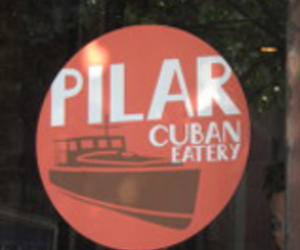House-made Chorizo and Guava Cream Cheese Pie
- Submitted by: manso
- Business and Economy
- 07 / 24 / 2011

Delicious bites at Pilar Cuban Eatery. By Gwen Ruelle. July 22, 2011. “I’ve been a foodie since before the term ‘foodie’ ever existed,” Ricardo Barreras, chef and owner of Pilar Cuban Eatery, told me. “By fifteen I was cooking for groups of twenty.”
Barreras was born and raised in Miami, but his entire family hails from Cuba. He learned how to cook from his grandfather, who taught him to make dishes he still serves at Pilar today.
“The first dish I ever made was arroz con pollo,” said Barreras, and he has been cooking ever since.
The Cuban eatery is named after Hemmingway’s boat which he built in Brooklyn in 1934 and later docked in Havana, Cuba. It offers a bridge between the two cities, as does Barreras with his food.
Every day of the week, Pilar features a different entree and soup option, along with the regular dishes - croquettes, cuban sandwiches, Spanish tortillas, wraps, empanadas, and passion fruit flan, to name just a few.
I started off with a cup of iced mint green tea, which tasted heavenly in this 100 degree weather.
After positioning myself directly in front of the air conditioner, I tried a bowl of Caldo Gallego, a white bean stew with ham, potato, chorizo, and greens. For five dollars, this stew is a great lunch option.
Filled with firm white beans and thick chunks of potatoes and ham, this is one of the most filling soups I’ve ever tried. All the ingredients melt together with a prevailing smokey flavor, that goes well with the almost creamy consistency of the soup.
Next up, a personal favorite that originates from Spain (Cuban food is strongly influenced by Spanish cooking), the Tortilla Española with slices of house-made chorizo. The tortilla is most similar to a fritatta, made with egg and chunks of potato, and cut like a pie. The mild flavor brings out the strong taste of the chorizo.
The chorizo is another family recipe, passed down from Barreras’s great grandparents from Galicia, Spain. When his parents went to visit, they would bring back the chorizo wrapped in soap so that customs wouldn’t catch it and throw it away. Barreras remembers the chorizo being a huge part of his childhood, and has spent years trying to replicate it.
The meat is ground up and seasoned and then smoked at a low temperature over a long period of time, giving it an intense smoked flavor mixed with the sharp taste of imported Spanish paprika.
If you go to Pilar, you absolutely have to try a dish that includes the chorizo, if only because the taste of fresh chorizo from scratch is completely unlike any chorizo (or meat, for that matter) you will have elsewhere.
The Pernil, or roast pork, is, as Barreras said, “kind of the national dish.” The meat falls apart into soft strings of delicious, tender meat, full of salty, succulent juices that add a ton of flavor to the sides: soupy black beans, buttery white rice, and sweet plantains.
You can also opt for the Vacas Fritas with the same sides, which, literally translated means “fried cow” (but, as Barreras pointed out, is never fried). This meal is chunks of skirt steak seared with garlic, onions, and lime. The garlic is the prevalent flavor, which compliments the dark heavy meat and is freshened by the subtle flavor of lime.
Both these meals go for just under $10, and are sure to fill even the hungriest of eaters.
For dessert, try the guava and cream cheese pie. It is as delicious as it sounds - a flaky pie crust with sweet guava preserve that tastes of the tropics. The cream cheese filling is thick and creamy, with a similar consistency to a heavy cheesecake, but since this only makes up a thin layer of the pie, it is in no way overpowering.
Once you taste the food here, you’ll have a hard time believing that Barreras hasn’t spent decades in the restaurant business.
He calls it “Cuban food from a foodie approach,” saying, “I tried to capture as much of the repertoire of Cuban food, given the space.”
Don’t be turned off by the small space and limited seating - this tiny restaurant can pack a punch!
Second best to docking your boat in sunny Havana must be some freshly made chorizo and a slice of guava cream cheese pie.
Source: http://bed-stuy.patch.com/articles/house-made-chorizo-and-guava-cream-ch...
Comments